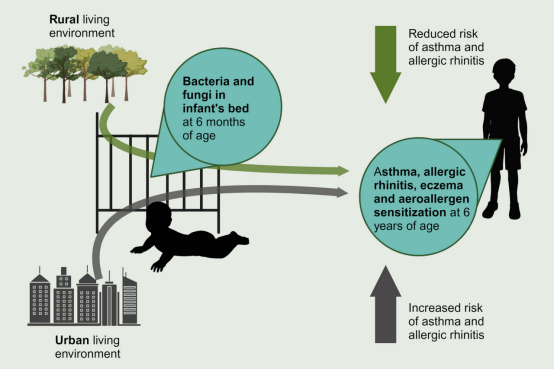Clin Exp Allergy:農(nóng)村和城市嬰兒床上的真菌和細(xì)菌與日后患特應(yīng)性疾病的風(fēng)險(xiǎn)相關(guān)
發(fā)布日期:2023-10-31
——浙大迪迅 譯
背景:農(nóng)村兒童患哮喘和特應(yīng)性疾病的風(fēng)險(xiǎn)比城市兒童低。然而,非農(nóng)業(yè)農(nóng)村家庭的室內(nèi)微生物群是否能提供保護(hù)尚不清楚。
方法:研究旨在探究農(nóng)村和城市嬰兒床上的微生物是否與特應(yīng)性疾病的后期發(fā)展有關(guān)。在COPSAC2010前瞻性隊(duì)列研究中,研究了6個(gè)月大嬰兒(n = 514)床上真菌和細(xì)菌與6歲時(shí)哮喘、變應(yīng)性鼻炎、濕疹和氣致過(guò)敏原致敏風(fēng)險(xiǎn)的關(guān)系。
結(jié)果:后來(lái)發(fā)生變應(yīng)性鼻炎的兒童床上真菌和細(xì)菌多樣性較低(?0.22[?0.43,?0.01],padj?=?0.04和?.24[?0.42,?0.05],padj?=?0.01),并且在后來(lái)發(fā)展為哮喘(?41.34[?76.95,?5.73],padj?=?0.02)或過(guò)敏性鼻炎(?45.65[?81.19,?10.10],padj?=0?.01)的兒童床上發(fā)現(xiàn)了較低的細(xì)菌豐富度。有趣的是,在發(fā)生濕疹的兒童床上發(fā)現(xiàn)了更高的真菌多樣性和豐富度(0.23 [0.02,0.43],padj =0.03和29.21 [1.59,56.83],padj =0.004)。本研究定義了一組有限的真菌和細(xì)菌屬來(lái)預(yù)測(cè)農(nóng)村/城市環(huán)境。一些與農(nóng)村相關(guān)的細(xì)菌屬,如羅姆布茨菌和芽孢桿菌,以及真菌屬,如戴頓斯氏格孢和蜈蚣衣,也與包括濕疹在內(nèi)的疾病風(fēng)險(xiǎn)降低有關(guān)。這些預(yù)測(cè)生活環(huán)境的真菌和細(xì)菌與哮喘和過(guò)敏性鼻炎有關(guān),但與濕疹無(wú)關(guān),農(nóng)村成分具有保護(hù)作用。床塵細(xì)菌介導(dǎo)了27%的農(nóng)村生活環(huán)境對(duì)變應(yīng)性鼻炎的保護(hù)作用(p = 0.04)。
結(jié)論:床塵微生物可能與氣道和皮膚相關(guān)疾病有不同的相關(guān)性。農(nóng)村和城市嬰兒不同的床塵微生物群可能會(huì)影響他們以后患哮喘和過(guò)敏性鼻炎的風(fēng)險(xiǎn)。

原始出處
Clin Exp Allergy
[IF: 5.131]
Fungi and bacteria in the beds of rural and urban infants correlate with later risk of atopic diseases
DOI: 10.1111/cea.14414
Abstract:
Introduction:Rural children have a lower risk of asthma and atopic diseases than urban children. However, whether indoor microbiota in non-farming rural homes provides protection is unclear.
Methods:Here, we examine if microbes in the beds of rural and urban infants are associated with later development of atopic diseases. We studied fungi and bacteria in the beds of 6-month-old infants (n?=?514) in association with the risk of asthma, allergic rhinitis, eczema and aeroallergen sensitization at 6?years of age in the prospective COPSAC2010 cohort.
Results:Both fungal and bacterial diversity were lower in the beds of children, who later developed allergic rhinitis (?0.22 [?0.43,?0.01], padj?=?.04 and ?.24 [?0.42,?0.05], padj?=?.01 respectively) and lower bacterial richness was discovered in beds of children later developing asthma (?41.34 [?76.95,?5.73], padj?=?.02) or allergic rhinitis (?45.65[?81.19,?10.10], padj?=?.01). Interestingly, higher fungal diversity and richness were discovered in the beds of children developing eczema (0.23 [0.02,0.43], padj?=?.03 and 29.21 [1.59,56.83], padj?=?.04 respectively). We defined a limited set of fungal and bacterial genera that predicted rural/urban environment. Some rural-associated bacterial genera such as Romboutsia and Bacillus and fungal genera Spegazzinia and Physcia were also associated with reduced risk of diseases, including eczema. These fungal and bacterial fingerprints predicting the living environment were associated with asthma and allergic rhinitis, but not eczema, with rural compositions being protective. The bed dust bacteria mediated 27% of the protective association of a rural living environment for allergic rhinitis (p?=?.04).
Conclusions:Bed dust microbes can be differentially associated with airway- and skin-related diseases. The differing bed dust microbiota between rural and urban infants may influence their later risk of asthma and allergic rhinitis.
First Author:
Jenni Lehtim?ki
Corresponding author:
Jakob Stokholm
Correspondence:
COPSAC, Copenhagen Prospective Studies on Asthma in Childhood, Herlev and Gentofte Hospital, University of Copenhagen, Ledreborg Alle 34, Gentofte 2820, Denmark.
Email: stokholm@copsac.com
Clin Exp Allergy
[IF: 5.131]
Fungi and bacteria in the beds of rural and urban infants correlate with later risk of atopic diseases
DOI: 10.1111/cea.14414
Abstract:
Introduction:Rural children have a lower risk of asthma and atopic diseases than urban children. However, whether indoor microbiota in non-farming rural homes provides protection is unclear.
Methods:Here, we examine if microbes in the beds of rural and urban infants are associated with later development of atopic diseases. We studied fungi and bacteria in the beds of 6-month-old infants (n?=?514) in association with the risk of asthma, allergic rhinitis, eczema and aeroallergen sensitization at 6?years of age in the prospective COPSAC2010 cohort.
Results:Both fungal and bacterial diversity were lower in the beds of children, who later developed allergic rhinitis (?0.22 [?0.43,?0.01], padj?=?.04 and ?.24 [?0.42,?0.05], padj?=?.01 respectively) and lower bacterial richness was discovered in beds of children later developing asthma (?41.34 [?76.95,?5.73], padj?=?.02) or allergic rhinitis (?45.65[?81.19,?10.10], padj?=?.01). Interestingly, higher fungal diversity and richness were discovered in the beds of children developing eczema (0.23 [0.02,0.43], padj?=?.03 and 29.21 [1.59,56.83], padj?=?.04 respectively). We defined a limited set of fungal and bacterial genera that predicted rural/urban environment. Some rural-associated bacterial genera such as Romboutsia and Bacillus and fungal genera Spegazzinia and Physcia were also associated with reduced risk of diseases, including eczema. These fungal and bacterial fingerprints predicting the living environment were associated with asthma and allergic rhinitis, but not eczema, with rural compositions being protective. The bed dust bacteria mediated 27% of the protective association of a rural living environment for allergic rhinitis (p?=?.04).
Conclusions:Bed dust microbes can be differentially associated with airway- and skin-related diseases. The differing bed dust microbiota between rural and urban infants may influence their later risk of asthma and allergic rhinitis.
First Author:
Jenni Lehtim?ki
Corresponding author:
Jakob Stokholm
Correspondence:
COPSAC, Copenhagen Prospective Studies on Asthma in Childhood, Herlev and Gentofte Hospital, University of Copenhagen, Ledreborg Alle 34, Gentofte 2820, Denmark.
Email: stokholm@copsac.com
 杭州浙大迪迅生物基因工程有限公司
杭州浙大迪迅生物基因工程有限公司

